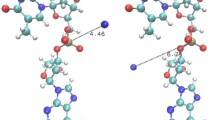Abstract
High level ab initio studies demonstrate substantial conformational flexibility of amino groups of nucleic acid bases. This flexibility is important for biological functions of DNA. Existing force field models of molecular mechanics do not describe this phenomenon due to a lack of quantitative experimental data necessary for an adjustment of empirical parameters. We have performed extensive calculations of nucleic acid bases at the MP2/6-31G(d,p) level of ab initio theory for broad set of amino group configurations. Two-dimensional maps of energy and geometrical characteristics as functions of two amino hydrogen torsions have been constructed. We approximate the maps by polynomial expressions, which can be used in molecular mechanics calculations. Detailed considerations of these maps enable us to propose a method for determination of numerical coefficients in the developed formulae using restricted sets of points obtained via higher-level calculations.
Similar content being viewed by others
References
Hays, F.A., Teegarden, A., Jones, Z.J.R., Harms, M., Raup, D., Watson, J., Cavaliere, E., Ho, P.S.: How sequence defines structure: a crystallographic map of DNA structure and conformation. Proc. Natl. Acad. Sci. 102, 7157 (2005)
Chou, S.-H., Chin, K.-H., Wang, A.H.-J.: Unusual DNA duplex and hairpin motifs. Nucleic Acids Res. 31, 2461 (2003)
Pallan, P.S., Lubini, P., Bolli, M., Egli, M.: Backbone-base inclination as a fundamental determinant of nucleic acid self- and cross-pairing. Nucleic Acids Res. 35, 6611 (2007)
Parvathy, V.R., Bhaumik, S.R., Chary, K.V.R., Govil, G., Liu, K., Howard, F.B., Miles, H.T.: NMR structure of a parallel-stranded DNA duplex at atomic resolution. Nucleic Acids Res. 30, 1500 (2002)
Pfaff, D.A., Clarke, K.M., Parr, T.A., Cole, J.M., Geierstanger, B.H., Tahmassebi, D.C., Dwyer, T.J.: Solution structure of a DNA duplex containing a guanine-difluorotoluene pair: a wobble pair without hydrogen bonding? J. Am. Chem. Soc. 130, 4869 (2008)
Matsugami, A., Ohyama, T., Inada, M., Inoue, N., Minakawa, N., Matsuda, A., Katahira, M.: Unexpected A-form formation of 4’-thioDNA in solution, revealed by NMR, and the implications as to the mechanism of nuclease resistance. Nucleic Acids Res. 36, 1805 (2008)
Cornell, W.D., Cieplak, P., Bayly, C.I., Gould, I.R., Merz, K.M. Jr., Ferguson, D.M., Spellmeyer, D.C., Fox, T., Caldwell, J.W., Kollman, P.A.: A second generation force field for the simulation of proteins, nucleic acids, and organic molecules. J. Am. Chem. Soc. 117, 5179 (1995)
MacKerell, A.D. Jr., Bashford, D., Bellott, R.L., Dunbrack, R.L. Jr., Evanseck, J.D., Field, M.J., Fischer, S., Gao, J., Guo, H., Ha, S., Joseph-McCarthy, D., Kuchnir, L., Kuczera, K., Lau, F.T.K., Mattos, C., Michnick, S., Ngo, T., Nguyen, D.T., Prodhom, B., Reiher, W.E., III, Roux, B., Schlenkrich, M., Smith, J.C., Stote, R., Straub, J., Watanabe, M., Wiorkiewicz-Kuczera, J., Yin, D., Karplus, M.: All-atom empirical potential for molecular modeling and dynamics studies of proteins. J. Phys. Chem. B 102, 3586 (1998)
Pearlman, D.A., Case, D.A., Caldwell, J.W., Ross, W.S., Cheatham, T.E. III, DeBolt, S., Ferguson, D., Seibel, G., Kollman, P.: Amber, a package of computer programs for applying molecular mechanics, normal mode analysis, molecular dynamics and free energy calculations to simulate the structural and energetic properties of molecules. Comput. Phys. Commun. 91, 1 (1995)
Brooks, B.R., Bruccoleri, R.E., Olafson, B.D., States, D.J., Swaminathan, S., Karplus, M.: CHARMM. A program for macromolecular energy, minimization, and dynamics calculations. J. Comp. Chem. 4, 187 (1983)
Poltev, V.I., Shulyupina, N.V.: Simulation of interactions between nucleic acid bases by refined atomatom potential functions. J. Biomol. Struct. Dyn. 4, 739 (1986)
Poltev, V.I., Deriabina, A.S., Gonzalez, E., Grokhlina, T.I.: Interactions between nucleic acid bases: new parameters of potential functions and new energy minima. Biophysics 47, 972 (2002)
Scordamaglia, R., Cavallone, F., Clementi, E.: Analytical potentials from “ab initio” computations for the interaction between biomolecules. 2. Water with the four bases of DNA. J. Am. Chem. Soc. 99, 5545 (1977)
Halgren, T.A.: Merck molecular force field. I. Basis, form, scope, parameterization and performance of MMFF94. J. Comput. Chem. 17, 490 (1996)
Song, K., Hornak, V., De Los Santos, C., Grollman, A.P., Simmerling, C.: Molecular mechanics parameters for the FapydG DNA lesion. J. Comput. Chem. 29, 17 (2008)
Oda, A., Yamaotsu, N., Hirono, S.: New AMBER force field parameters of heme iron for cytochrome P450s determined by quantum chemical calculations of simplified models. J. Comput. Chem. 26, 818 (2005)
Leszczynski, J.: Are the amino groups in the nucleic acid bases coplanar with the molecular rings? Ab initio HF/6-31G* and MP2/6-31G* studies. Int. J. Quantum Chem. Quantum Biol. Symp. 19, 43 (1992)
Sponer, J., Florian, J., Leszczynski, J., Hobza, P.: Nonplanar DNA base pairs. J. Biomol. Struct. Dyn. 13, 827 (1996)
Hovorun, D.M., Gorb, L., Leszczynski, J.: From the nonplanarity of the amino group to the structural nonrigidity of the molecule: A post-hartree—fock ab initio study of 2-aminoimidazole. Int. J. Quantum Chem. 75, 245 (1999)
Sponer, J., Leszczynski, J., Hobza, P.: Electronic properties, hydrogen bonding, stacking, and cation binding of DNA and RNA bases. Biopolymers 61, 3 (2002)
Nelson, H.C.M., Finch, J.T., Luisi, B.F., Klug, A.: The structure of an oligo(dA) oligo(dT) tract and its biological implications. Nature 330, 221 (1987)
Prive, G.G., Heinemann, U., Chandrasegaran, S., Kan, L.-S., Kopka, M.L., Dickerson, R.E.: Helix geometry, hydration, and G.A mismatch in a B-DNA decamer. Science 38, 498 (1987)
Ryjáček, F., Kubar, T., Hobza, P.: New Parameterization of the Cornell et al. empirical force field covering amino group nonplanarity in nucleic acid bases. J. Comput. Chem. 24, 1891 (2003)
Poltev, V.I., Gonzalez, E., Deriabina, A.S., Lozano, L., Martinez, A., Robinson, T., Gorb, L., Leszczynski, J.: J. Mol. Struct. (Theochem) 729, 59 (2005)
Wang, S., Schaefer, H.F. III: The small planarization barriers for the amino group in the nucleic acid bases. J. Chem. Phys. 124, 044303 (2006)
Author information
Authors and Affiliations
Corresponding author
Rights and permissions
About this article
Cite this article
Poltev, V.I., Gonzalez, E., Deriabina, A. et al. Electron Correlated Ab Initio Study of Amino Group Flexibility for Improvement of Molecular Mechanics Simulations on Nucleic Acid Conformations and Interactions. J Biol Phys 33, 499–514 (2007). https://doi.org/10.1007/s10867-008-9091-2
Received:
Accepted:
Published:
Issue Date:
DOI: https://doi.org/10.1007/s10867-008-9091-2




